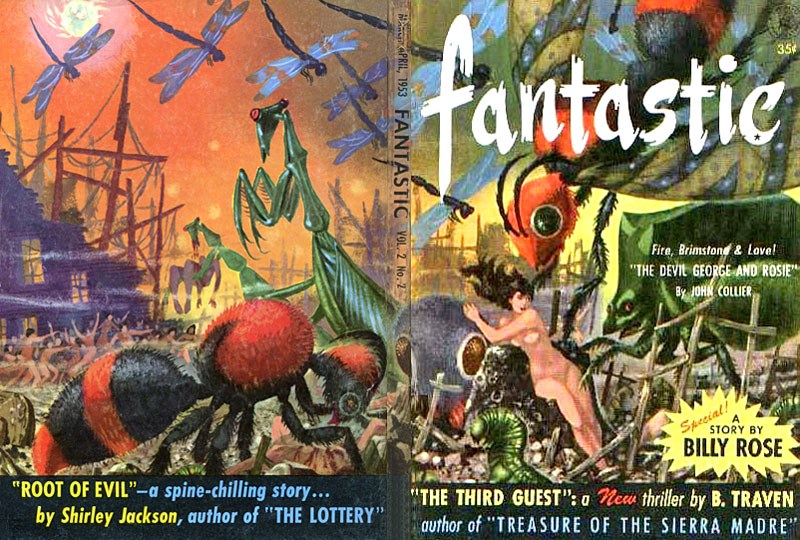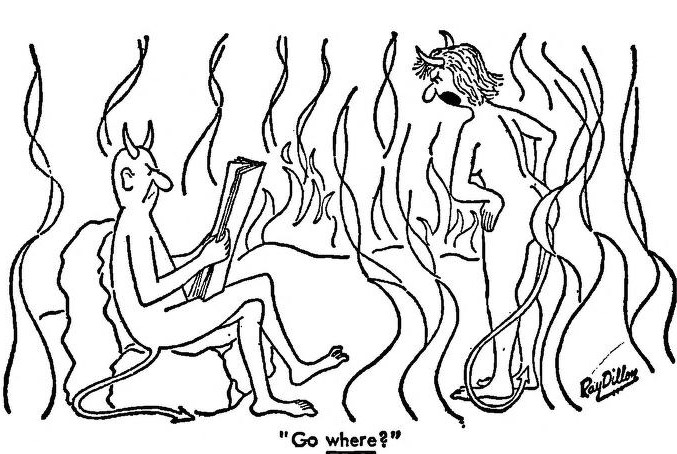
by Victoria Silverwolf
It's a Bird! It's a Plane! It's . . . a Meteor? A Satellite? A Flying Saucer?
Things got off to a bang earlier this month, in a most unexpected way. On the evening of December 9, folks in Canada and the United States saw a fireball in the sky. According to witnesses, something crashed in the woods near the town of Kecksburg, Pennsylvania.
(Cue eerie theremin music.)
The US military and state troopers sealed off the area and began a search. So far, they haven't reported finding anything.
(That's what they want you to think.)

Isn't this the way The Blob started?
After eliminating things like a plane crash, the authorities seem to think the most likely suspect is a meteor that exploded in the atmosphere. (Vocabulary lesson for today: A very bright meteor, particularly one that blows up spectacularly, is known as a bolide.) It might possibly be debris from a satellite, some suggest. Of course, you and I know it's really little green men . . .
Another Song of Solomon?
Almost as surprising as a blazing visitor from outer space is a modern pop song with lyrics that are a couple of thousand years old. The Byrds are currently at the top of the American music charts with their version of Turn! Turn! Turn!
Composed by folk singer Pete Seeger, almost all the words are taken from the Old Testament book Ecclesiastes, supposedly written by King Solomon. The exceptions are the title, repeated several times, and the closing line I swear it's not too late, emphasizing the song's antiwar message.

She don't care about grammar either, I guess.
What Do You Expect For Four Bits?
Appropriately, the latest issue of Fantastic is full of unexpected happenings.

Cover art by James B. Settles, taken from the back cover of the August 1942 issue of Amazing Stories.

The best copy I can find of the original. Please excuse the tiny print. I doubt this is a very accurate representation of the planet Uranus anyway.
Six and Ten Are Johnny, by Walter M. Miller, Jr.

Cover art by Barye Phillips and Leo Summers.
From the very first issue of Fantastic comes this tale of an unexpected encounter on a distant world.

Illustrations by Virgil Finlay.
A shuttle carries a survey team from a starship down to the surface of the planet. The crew has an uneasy feeling about the place, for no obvious reason. They land on a plateau above a dense jungle. They are shocked to meet Johnny, who claims to be the sole survivor of a lost starship. Things get even weirder when some of the crew members vanish, and the others claim that they never even existed.

Officers from the starship join the survey team in an attempt to figure out what's going on.
Everybody seems to be in a dazed condition, except the protagonist. That's because he's got a metal plate in his head, which protects him from having his mind controlled by the alien organism that makes up the jungle.

The wild-eyed madman in this picture is actually our completely sane hero, who is trying to protect a colleague from the creature's telepathic powers.
This is a grim little science fiction horror story with a feverish, eerie mood. I'm not sure I believe the way the alien organism works, or if the behavior of the crew is plausible. (Would you really bring a bunch of dogs on a starship to test if a planet's atmosphere is breathable? Of course, the real reason they're present is so they can go crazy and bark wildly, like in any scary movie.) Not the most profound story in the world, but a competent spine chiller.
Three stars.
Wonder Child, by Joseph Shallit

Cover art by Robert Frankenberg.
The January/February 1953 issue of the magazine supplies this account of an invention with unexpected effects.

Illustrations by Ed Emshwiller (better known as Emsh.)
A married couple would like to have a child, but they don't want to deal with all the work of raising it from infancy. They happen to know a scientist who has created a gizmo that will speed up the nerve growth of a fetus in the womb. Their son develops rapidly, sparing them a lot of trouble with things like toilet training.

He also develops a precocious interest in sex.
Despite some problems with teachers, neighbors, and other kids, things seem to be going pretty well. What they don't know is that their acquaintance is a classic Mad Scientist, who has also given the child increased aggression. It's not hard to see that things won't work out for the best.
I found both the technology and the behavior of the characters implausible. The ending of the story left a bad taste in my mouth. I suppose the author does a decent job portraying a pair of self-centered bohemian parents, but they're not much fun to read about.
Two stars.
Axe and Dragon (Part Two of Three), by Keith Laumer
Let's take a break from reprints and turn to the latest installment in this new novel.

Illustrations by Gray Morrow.
As you may recall, the improbably named Lafayette O'Leary wound up in a strange, supposedly imaginary world through self-hypnosis. He has some control over things, creating food, drink, clothing, shelter, and the like. However, the place has a stubborn reality of its own.
After surviving a duel in a slapstick fashion, he winds up being framed for the kidnapping of the land's beautiful princess. Much running around follows, with O'Leary even creating a secret door for himself, so he can escape into it.

He also briefly returns to the so-called real world, where he runs afoul of the law.
Determined to clear his name, he sets out to rescue the princess from a fabled giant and his supposed dragon. Complicating matters is the king's magician, who has more advanced technology than you'd expect in this steam-powered world, and who seems to know more about what's going on than he admits.

There's also a big guy.
The mood remains very light, with even more comedy than the first part. The breakneck pace of events holds the reader's attention. Even if the whole thing could be dismissed as much ado about nothing, it provides adequate, forgettable entertainment.
Three stars.
What a Man Believes, by Robert Sheckley

Cover art by Vernon Kramer.
Back to reprints with this tale of the afterlife, from the November/December 1953 issue.

Illustrations by Henry C. Pitz.
A guy who didn't expect anything after death winds up in an oddly accommodating Hell. It seems he has a choice of eternal punishment: he can undergo physical torture, fight wolves, or drift in a boat.

He can also climb a mountain.
Predictably, he selects the boat, preferring endless boredom to unending agony. This leads to an ending that, well, didn't make a lot of sense to me. I suppose some irony is intended, but it falls flat.
Two stars.
Three Wishes, by Poul Anderson

Wraparound cover art by Richard Powers.
A nice old man makes an unexpected discovery in this yarn from the March/April 1953 issue.

Illustration by Dick Francis.
The elderly fellow is Papa Himmelschoen. If that sounds familiar, you're probably thinking of Papa Schimmelhorn, a character created by Reginald Bretnor in the story The Gnurrs Come from the Voodvork Out back in 1950. Anderson's old man has a similar thick accent, so I assume this is a deliberate allusion.
Anyway, the kindly Papa mends a pair of pants for a neighbor, and gets a little statue of a fairy as payment. It comes to life when, in a burst of gaiety, he kisses it. His reward is three wishes. Since he's completely happy with his life, he doesn't know how to use his wishes. The solution to his problem isn't completely satisfying, and involves a bit of circular reasoning.
This is a trivial work from a talented writer. The mood is pleasant enough, and Himmelschoen is a lot less obnoxious than Schimmelhorn, but it doesn't add up to much.
Two stars.

Cover art by J. Allen St. John.
From the yellowing pages of the March 1941 issue of Amazing Stories comes this piece, by an author better known as John Wyndham.

Illustration by Jay Jackson.
Neatly wrapping up the magazine with an incident similar to the one I mentioned at the start of this article, this story involves a mysterious object falling to Earth. Since the setting is England during the Second World War, the local folks treat it as a possible Nazi weapon.
Alternating sections of narration reveal that it's really a spaceship, carrying a large number of aliens from their dying world. It's obvious from the start, and the illustration, that they're tiny beings, so Earth seems like a planet full of giant monsters.
That's about all there is to the story. Beynon/Wyndham writes well enough, but I found the accounts of life in England during the Blitz more interesting than the science fiction stuff.
(Everybody seems very coolheaded when faced with this potentially deadly object. I suppose that's a bit of wartime propaganda, to maintain morale. Keep Calm and Carry On, and all that.)
Two stars.
Did It Meet Your Expectations?
I wasn't expecting this issue to be so weak, ranging from so-so to below average. I can understand the financial reason for using so many reprints — I believe the publishers have full rights to the stories and art, so they don't have to pay anything for them — but it results in a lot of disappointing early work from well-known writers. If I were in a worse mood, I'd be tempted to tell the editor exactly where he can go with all these old relics.

Cartoon by Ray Dillon. It's a reprint, too, from the same issue as Poul Anderson's story.

![[December 14, 1965] Expect the Unexpected (January 1966 <i>Fantastic</i>)](https://galacticjourney.org/wp-content/uploads/2020/12/Fantastic_v15n03_1966-01_0000-3-672x372.jpg)
